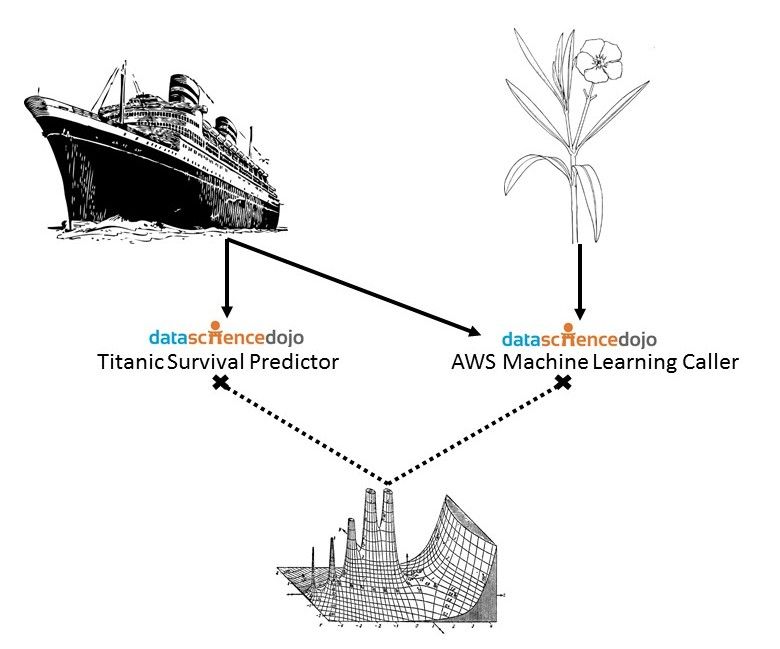Have you noticed that we have two machine learning demos on our site that allow you to deploy predictive models?
The Titanic Survival Predictor is designed to work with a Microsoft Azure model for machine learning. The AWS Machine Learning Caller is our new demo that connects to an Amazon Machine Learning model.
You can use Microsoft Azure ML or Amazon ML to build your machine learning model, but what’s the difference between the two approaches?
The idea is that you can use Microsoft Azure ML or Amazon ML to build a machine-learning model, and then use our demo to input values for the prediction.
Each ML program provides an endpoint that you can use to access the model and run predictions. Our demos interface with that endpoint and provide a graphic user interface for making predictions.
So, what’s the difference between the machine learning demos?
First of all, the backend is different. But we’ll keep this brief.
The graphic below shows what types of models can be run through the demo.
- The cruise ship represents the Titanic classification model generated from our Azure ML tutorial.
- The iris represents any classification model, such as a model used to predict species from a set of measurements.
- The complicated graph represents a regression model. Regression models are used to predict a number given a set of input numbers.

You can see that the Titanic model can link to both demos, but the classification (iris) model only links to our Amazon demo. The numerical dataset does not work with either of our demos.
The demos are currently limited to classification models only (because linear regression models work differently and requires a different backend).
MLaaS: User perspectives
From the user perspective, the Titanic Survival Predictor is built for a specific purpose. It interfaces with the exact Titanic classification model that we created for Azure and is included as part of our bootcamp. Users can change all the tuning parameters and make the model unique.
However, the input variables, or “schema” to be labeled the same way as the original model or it won’t work.
So, if you rename one of the columns, the demo will have an error. However, since we published the Azure model online, it’s pretty easy to copy the model and change some parameters.
To get your predictive model to work with our Titanic Survival Predictor demo, you’ll need the following information:
- Name (used to generate your own url)
- Post URL (or endpoint)
- API key
The AWS Machine Learning Caller is not built for a specific dataset like Titanic. It will work with any logistic regression model built in Amazon Machine Learning. When you input your access keys and model id, our demo automatically pulls the schema from Amazon.
It does not require a specific schema like our Titanic Survival Predictor.
To get your predictive model to work with our AWS Machine Learning Caller demo, you’ll need the following information:
- Access key
- Secret access key
- AWS Account Region
- AWS ML Model ID
Why do two machine learning demos do similar things?
These are training tools for our 5-day bootcamp. We use Microsoft Azure to teach classification models. The software has tools for data cleaning and manipulation. The way that the tools are laid out is visual and easy to understand. It provides a clear organization of the processes: input data, clean data, build a model, evaluate the model, and deploy the model.
Microsoft Azure has been a great way to teach the model-building process.
We’ve recently added Amazon Machine Learning to our curriculum. The program is simpler, where all the processes described above are automated. Amazon ML walks users through the process.
However, it does provide slightly different evaluation metrics than Microsoft Azure, so we use it to teach regression and classification models as well.
Help us get better!
We are always looking for ways to incorporate new tools into our curriculum. If there is a tool that you think we ought to have, please let us know in the comments.
Or, you can contact us here


